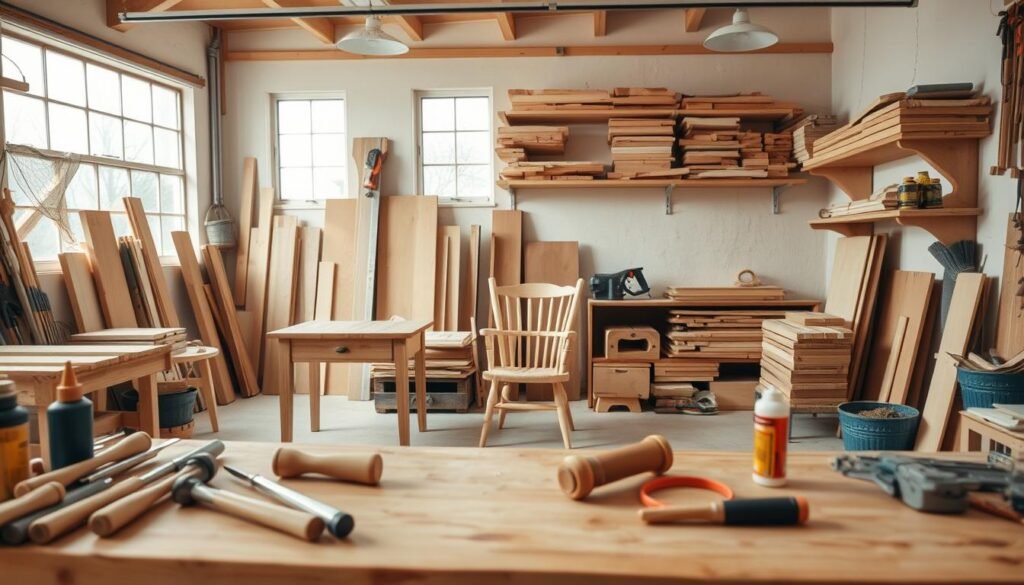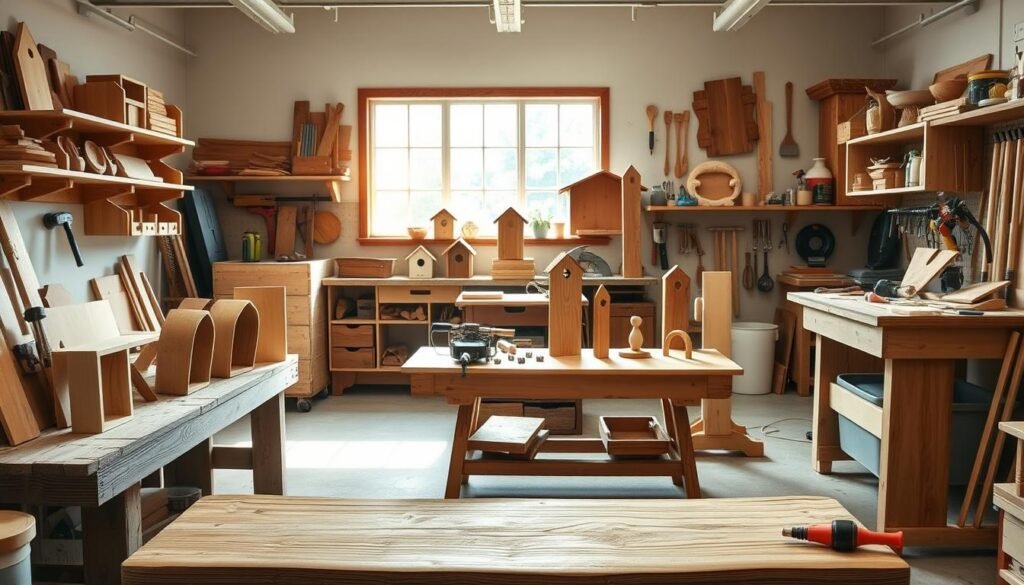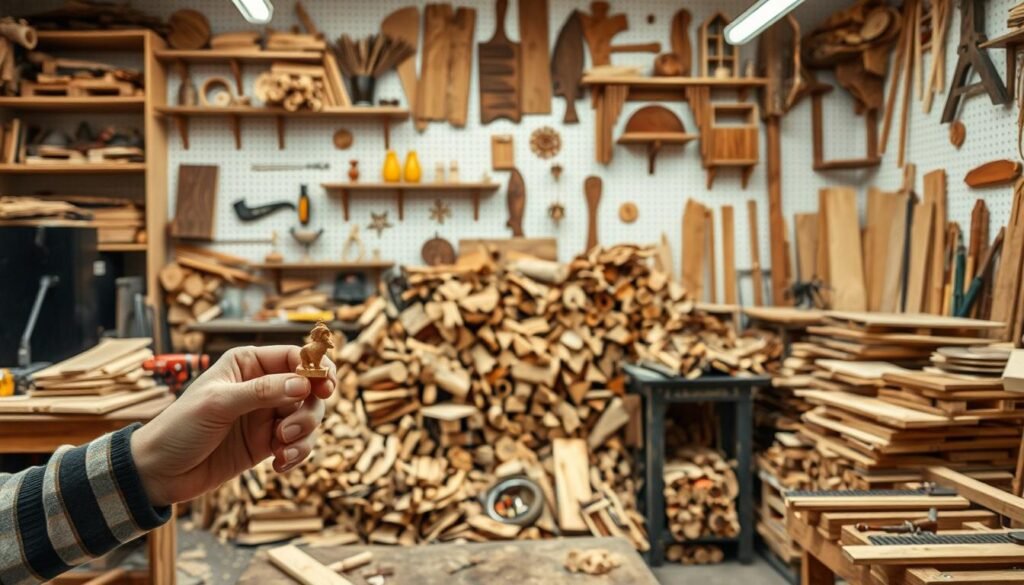It’s important to keep kids engaged in creative activities. Making wooden puzzles is a great way to do this. It’s fun and educational, perfect for parents and caregivers to do with their kids.
Building a wooden puzzle can be very rewarding. It helps improve problem-solving skills and hand-eye coordination. It’s a fun way to spend time together, creating memories and helping your child grow.
This activity is also a great way to boost critical thinking and spatial awareness. Crafting and solving puzzles is very fulfilling. It’s a great project for the whole family to enjoy together.
Why Make DIY Wooden Puzzles for Your Children
Creating DIY wooden puzzles is a fun way to help your child’s brain grow. It’s not just a toy; it’s a tool that boosts problem-solving and hand-eye skills. It’s a great way to make learning fun and interactive.
Doing puzzles can really help your child think better. It makes them think critically, understand space, and be creative. Solving puzzles helps them learn to analyze, think deeply, and make smart choices.
Enhancing Problem-Solving Skills
DIY wooden puzzles are great for improving problem-solving. Kids learn to think differently and creatively as they solve them. It’s a way to sharpen their critical thinking skills.
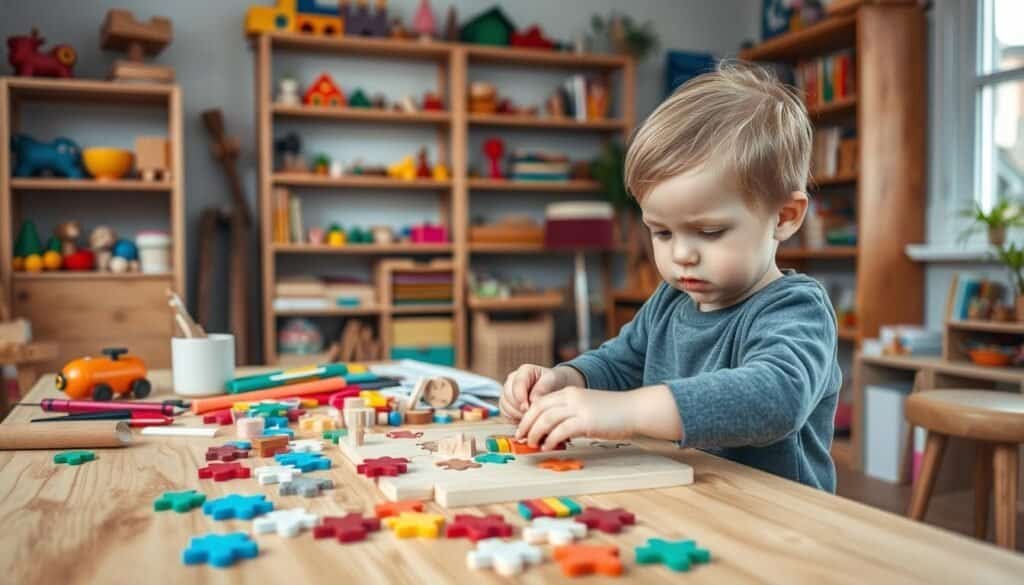
Plus, making puzzles together is a wonderful way to bond with your family. It’s a chance for parents to help and support their kids. This makes the bond stronger and creates special memories.
Adding DIY wooden puzzles to your child’s playtime is a smart move. It’s a fun and educational tool that helps them grow. It’s perfect for kids of all ages, making learning fun and engaging.
Essential Materials and Tools for Creating Wooden Puzzles
Making wooden puzzles is an art that starts with picking the right wood and tools. You’ll need a few key materials and tools to begin.
First, choose the wood for your puzzle. Birch, maple, and pine are good choices because they’re soft and easy to work with. The wood’s thickness depends on your puzzle’s design. For simple puzzles, 1/4 inch is usually enough.
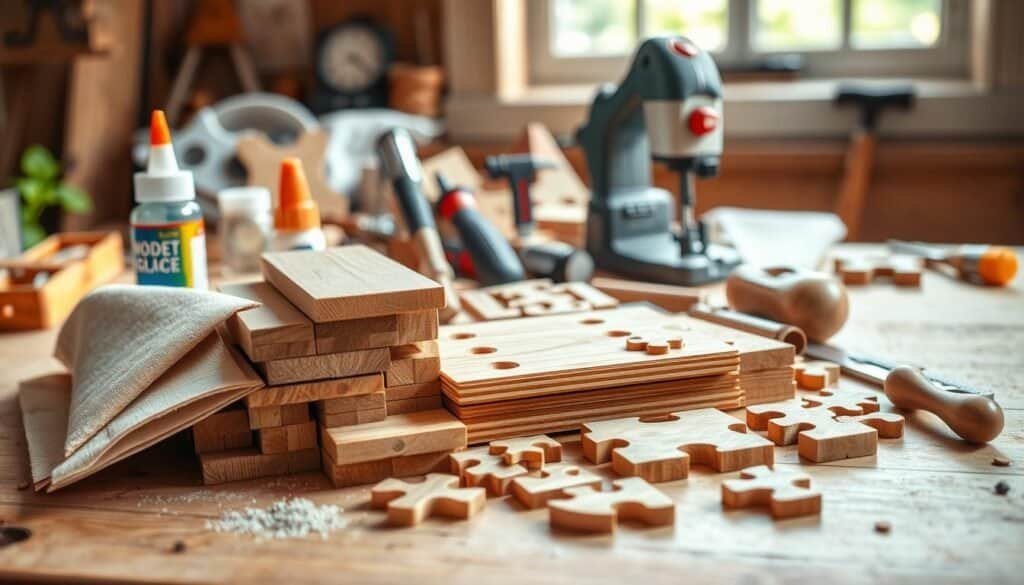
After picking your wood, you’ll need tools to cut and shape it. A jigsaw or coping saw works well for detailed cuts. Sandpaper is key for smooth edges and to avoid splinters. For complex designs, consider a CNC machine or laser cutter, but these are more advanced.
Safety Precautions for Working with Wood
Always prioritize safety when working with wood. Wear safety glasses and a dust mask to protect yourself from sawdust. Keep your workspace well-ventilated and avoid loose clothing or long hair to prevent accidents.
Also, follow the power tool instructions and keep your area clean. This way, you can safely enjoy making wooden puzzles and toys.
With the right materials and tools, and by following safety rules, you can make beautiful wooden puzzles. These puzzles will be fun for both kids and adults. The joy of creating something with your hands is rewarding, whether it’s a simple or complex puzzle.
Planning Your DIY Wooden Puzzle Project
Before starting your DIY wooden puzzle project, plan it for the child’s age and skill level. This step is key because it affects the puzzle’s complexity and fun.
Think about the puzzle’s theme and piece count. Younger kids do well with simple puzzles and fewer pieces. Older kids can tackle more complex puzzles with many pieces. You can find wood puzzles patterns online or design your own.
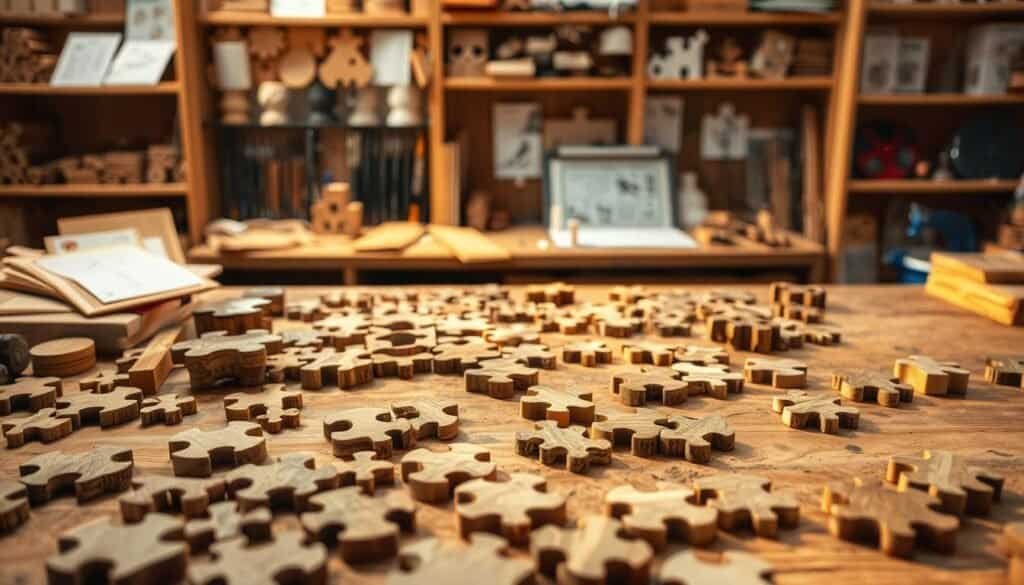
Considering Age and Skill Level
The child’s age and skill level are important for puzzle design. Toddlers need puzzles with big, easy pieces. As kids get older, you can make puzzles more challenging.
For a successful DIY wooden puzzle, have a solid plan. Choose the right wood, design the puzzle, and decide on the piece count. This way, you’ll create a unique puzzles experience that’s both fun and educational.
With careful planning, your wooden puzzle will entertain and teach your child. This makes your DIY wooden puzzle tutorial a valuable and fun experience.
Simple Wooden Jigsaw Puzzle Tutorial for Beginners
Making a simple wooden jigsaw puzzle is a fun DIY project. It’s great for beginners because it needs little equipment and basic woodworking skills.
You’ll need a hardwood like maple or birch, about 1/2 inch thick. The wood’s size depends on your puzzle’s size. A 12×12 inch piece is a good start for a standard puzzle.
First, cut the wood into puzzle pieces. Use a jigsaw or scroll saw for this. If you’re new, practice on scrap wood before cutting your puzzle.
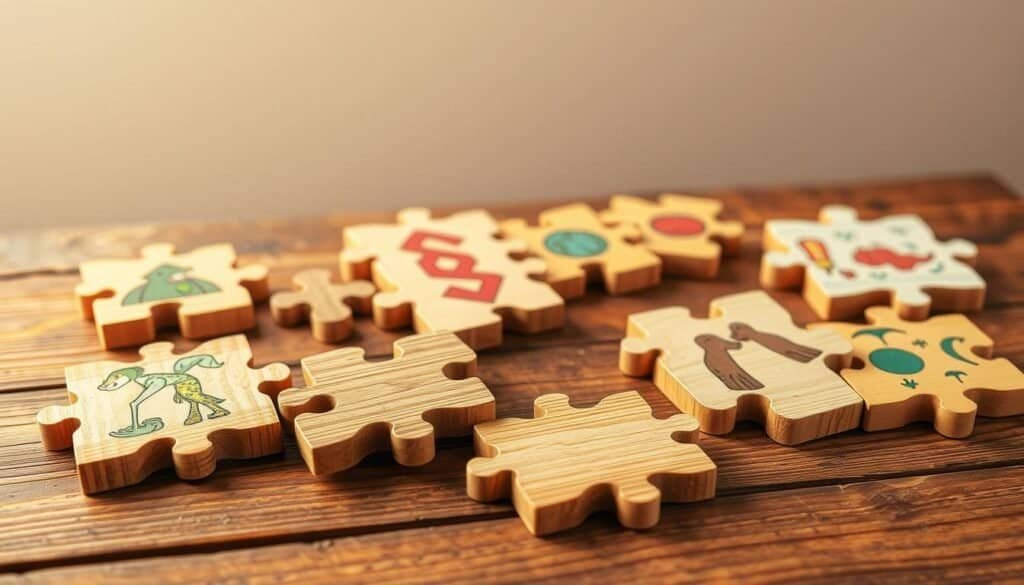
Next, sand the pieces to smooth out edges. This makes the puzzle fun to assemble. Use a sanding block or sandpaper for this.
Tips for a Smooth Finish
To get a smooth finish, sand all pieces well. You can also add a wood finish like varnish or polyurethane. This protects the wood and looks better.
Assembling the puzzle is the last step. You can make a simple puzzle or a more complex one. The puzzle’s complexity depends on your skill and who it’s for.
Creating a wooden jigsaw puzzle is a fun DIY project. It’s also a great gift or a way to spend time with loved ones. With these steps and tips, you can make your own wood puzzles diy and feel proud of your handmade project.
DIY Wooden Puzzle Tutorial: Fun and Educational for Kids & Family
Making a DIY wooden puzzle is a great way to bond with your family. It’s a fun activity that teaches kids valuable skills. It’s perfect for all ages, making it a great family project.
Wooden puzzle making boosts creativity and problem-solving in kids. It also helps adults connect with their children. This activity creates lasting memories.
Get your kids involved in choosing the puzzle’s design and difficulty. This lets them feel part of the project. It also teaches them about making decisions.
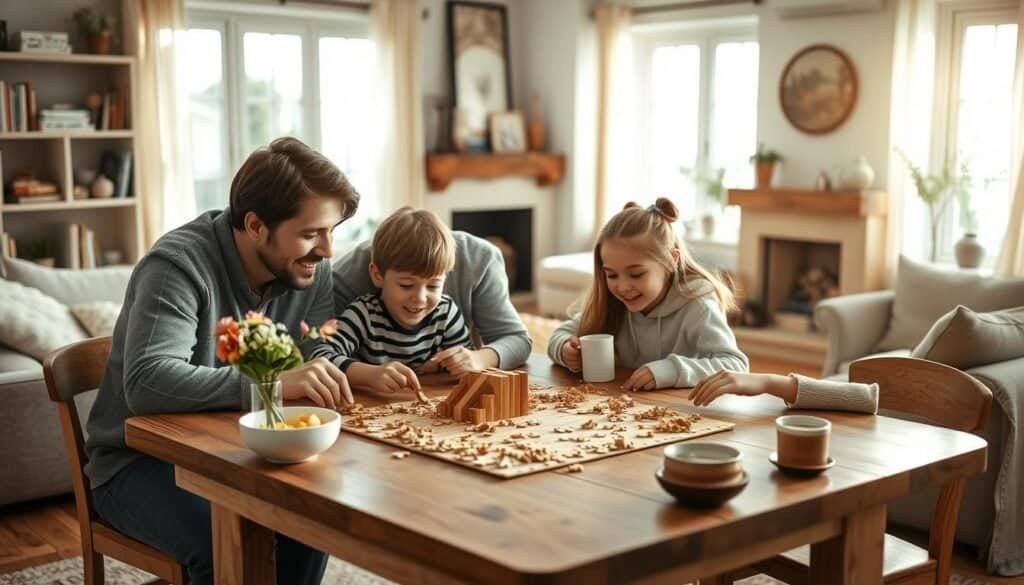
Working on a DIY wooden puzzle together strengthens family bonds. Assign tasks based on each person’s skills. Kids can sand or paint, while adults handle cutting and assembling.
This activity not only creates a fun puzzle but also brings your family closer. You’ll have meaningful conversations and laugh together. Completing the project feels rewarding.
Make wooden puzzles a regular family tradition. It’s a fun way to spend time together, away from screens. It’s a creative, hands-on activity that everyone will enjoy.
Creating 3D Wooden Puzzles for Advanced Learning
3D wooden puzzles are a great way to boost kids’ spatial skills and thinking. They are made to challenge kids and improve their problem-solving abilities.
When making 3D wooden puzzles, pick a design that fits your child’s age and skill. Start with simple puzzles and get more complex as your child grows.
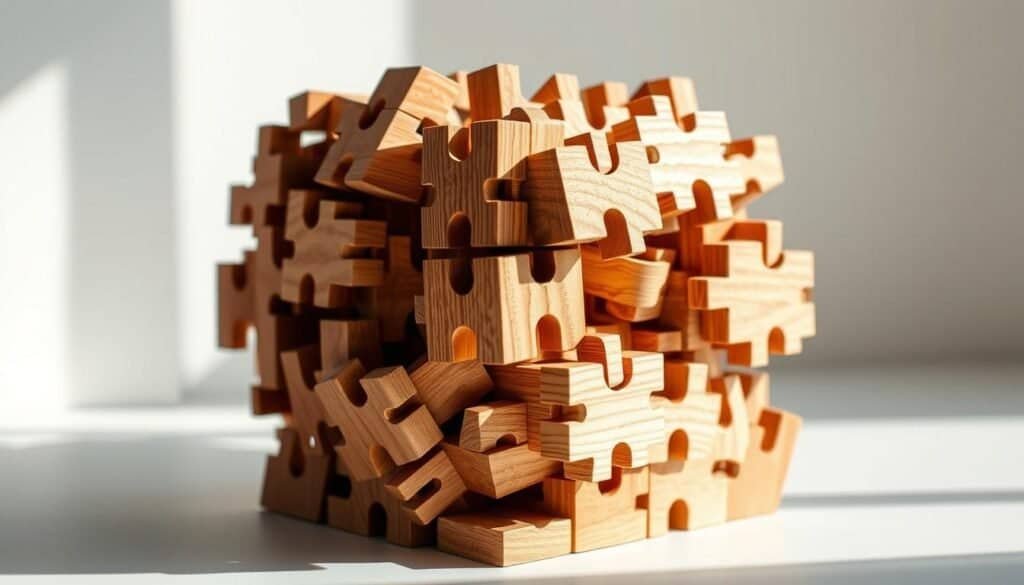
To make 3D wooden puzzles, you need to design, cut, and assemble the wood. You can use different woods and finishes to make the puzzle more interesting and long-lasting.
Benefits of 3D Puzzles for Cognitive Development
3D puzzles help kids think better by improving their spatial skills, problem-solving, and critical thinking. They also boost creativity and imagination as kids put the puzzle together.
Working on 3D puzzles also helps kids with their fine motor skills and hand-eye coordination. As they solve the puzzle, they learn to focus and keep trying when faced with challenges.
Adding 3D wooden puzzles to your child’s learning activities makes learning fun and engaging. They are perfect for homeschooling or classroom use.
In summary, making 3D wooden puzzles is a rewarding project that helps your child grow intellectually. With patience and effort, you can create puzzles that will keep your child interested and motivated.
Wooden Animal Puzzles: A Kid-Favorite Project
Looking for a fun DIY project? Try making wooden animal puzzles for kids. These puzzles are both entertaining and educational. They help kids improve their problem-solving and hand-eye coordination skills.
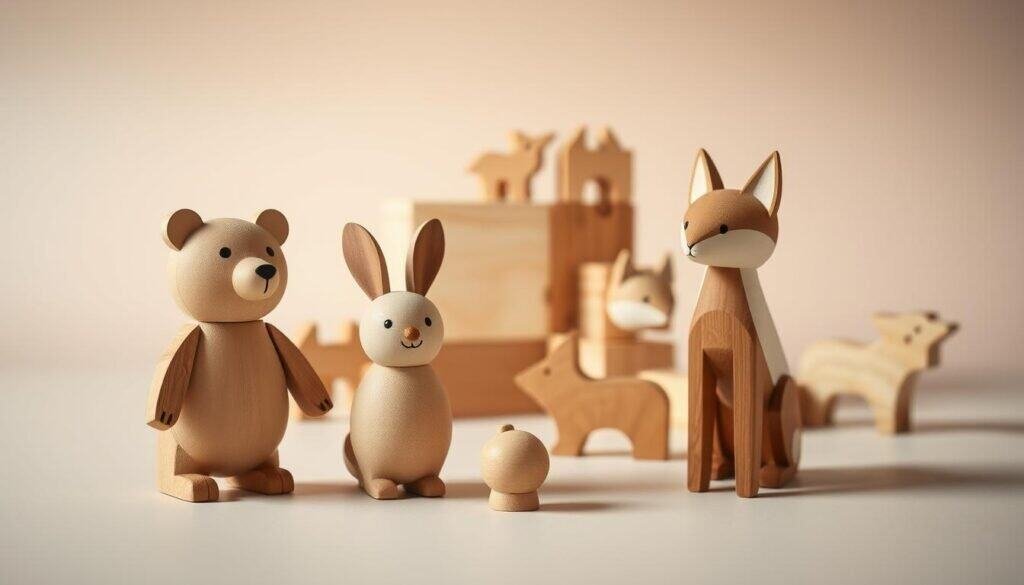
Kids love puzzles with animals because animals are their first love. You can make puzzles with various animal shapes and designs. This way, you can appeal to different interests and ages.
Tips for Creating Engaging Animal Puzzles
To make your puzzles more fun, follow these tips:
First, pick animal designs that kids can recognize but are also a bit challenging. Simple shapes like cats or dogs are perfect for younger kids. More complex designs like giraffes or elephants are great for older kids.
Second, use different wood types and colors to make the puzzles look good. Various textures and colors make the puzzle more appealing and fun for kids to solve.
Third, add educational elements to your puzzles. You can label the pieces with the animal’s name or include fun facts about the animal on the puzzle box.
By following these tips and making wooden animal puzzles with care, you’ll create a project that kids and parents will love. Whether you’re making simple “wooden figurines” or complex puzzle designs, your DIY project will be a success.
Alphabet and Number Puzzles for Early Learning
Alphabet and number puzzles are key for early learning. They boost literacy and numeracy skills in young ones. These puzzles make learning fun and hands-on.
Wooden alphabet and number puzzles are great for kids’ learning. They help kids learn letters and numbers. This lays a strong base for future school success.
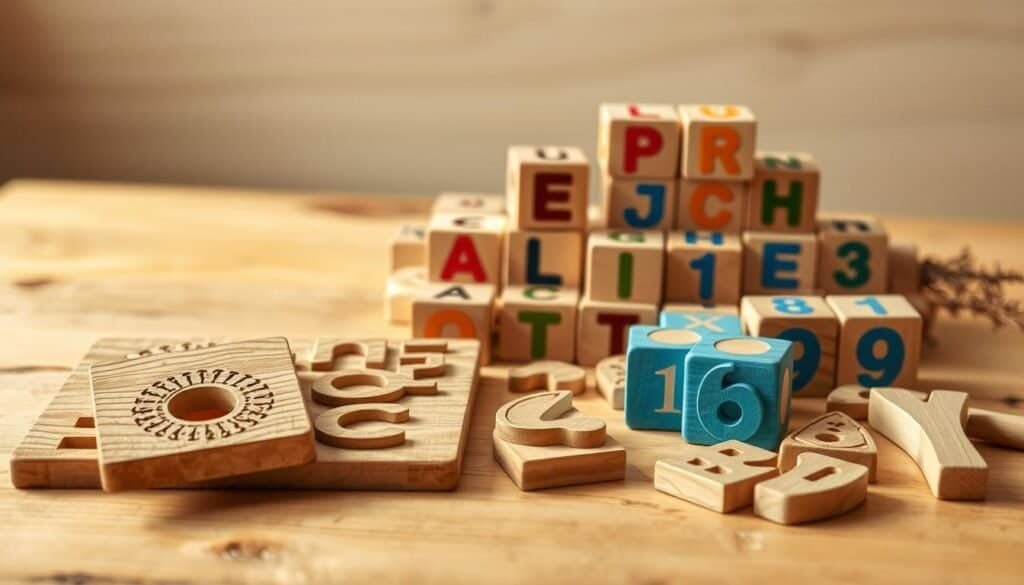
To make these puzzles, start by designing the layout. Choose the size and number of pieces. You can use a template or design your own.
Then, cut out the wooden pieces with a jigsaw or CNC machine. This depends on your tools and skills.
After cutting, sand the pieces to smooth them out. Paint or stain them to make them look nice. Assemble the puzzle by putting the pieces in order. Now, your child can enjoy this fun activity.
These puzzles are not just educational tools. They’re also a fun activity for the whole family. By making them, you spend quality time with your child.
Adding alphabet and number puzzles to your child’s daily routine is beneficial. It makes learning fun and engaging.
Wooden Transportation Toys and Puzzles
DIY wooden transportation toys are fun and good for kids’ brains. Making wooden toy cars and airplanes is a great activity for kids and parents. It teaches them about different ways to travel and helps them solve problems.
Start with simple puzzles like toy cars and then try more complex ones like airplanes. Adding different shapes and colors makes puzzles more fun for kids.
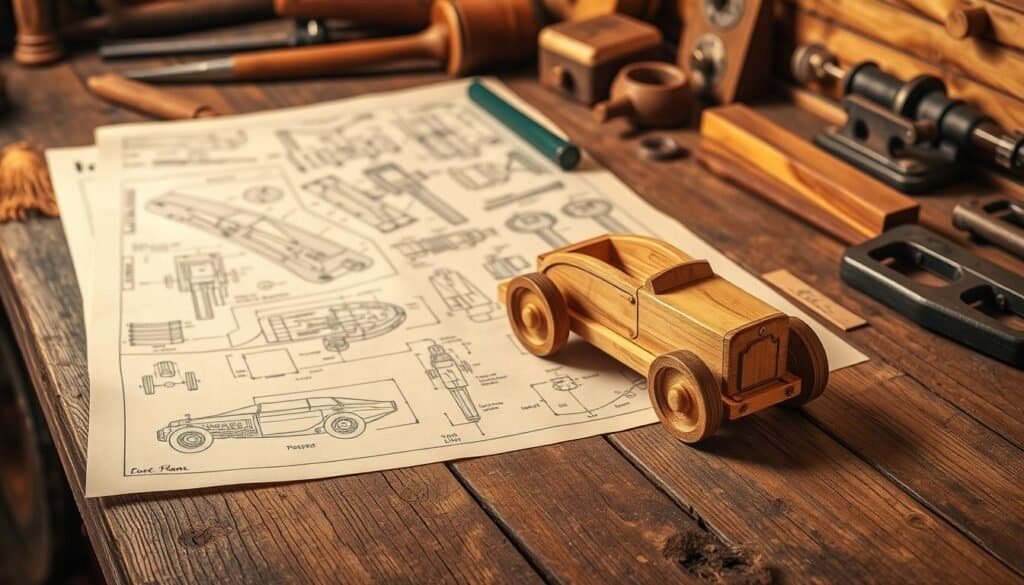
Make wooden toys more exciting by adding movable parts. You can also design different airplanes. Adding labels to the vehicles makes learning fun.
Let your child help pick the colors and designs. This makes the toy special and more interesting for them. It’s a fun way to work together.
With these ideas, you can make wooden toys that are both fun and educational. They will spark your child’s imagination and keep them entertained for hours.
Finishing and Decorating Your Wooden Puzzles
Finishing and decorating your wooden puzzle lets you show off your creativity. It makes your puzzle truly unique. You can use several techniques to make it look better and last longer.
Staining is a popular way to finish wooden puzzles. It adds color and protects the wood. You can pick from many stains to match your style. For a wooden puzzle craft, choose a stain that highlights the wood grain for a stunning contrast.
Painting is another great way to decorate your puzzle. Use acrylic paints for bright colors and designs. This is perfect for themed puzzles, like animal or alphabet puzzles.
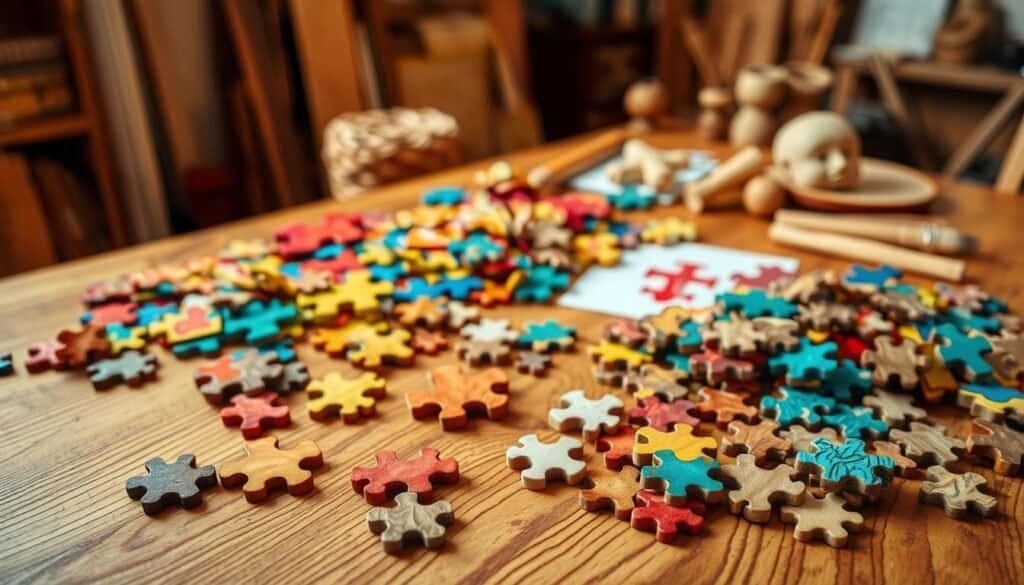
Varnishing is key to protect your puzzle from damage. It also makes it look better with a glossy or matte finish. Choose what you like best.
Decorating Ideas to Make Puzzles More Appealing
To make your puzzles more interesting, add decorative touches. For puzzle boxes or storage, use fancy hinges or handles. For detailed designs, try laser-cut patterns or engravings.
Other ideas include decoupage, stickers, decals, or adding natural elements like leaves or flowers under varnish. The most important thing is to have fun and be creative.
By using these techniques, you can turn your wooden puzzles into unique items. They’ll be fun, educational, and beautiful. Whether for yourself or as a gift, the right finishing touches can make a big difference.
Troubleshooting Common DIY Wooden Puzzle Challenges
Even with careful planning, DIY wooden puzzle makers may face challenges. Whether you’re a beginner or an experienced craftsman, knowing how to solve common problems can save time. It ensures your project turns out as expected.
One common issue is uneven cuts or pieces that don’t fit right. To avoid this, use sharp blades and keep your cutting precise. Regularly check your tools and equipment to prevent these problems.
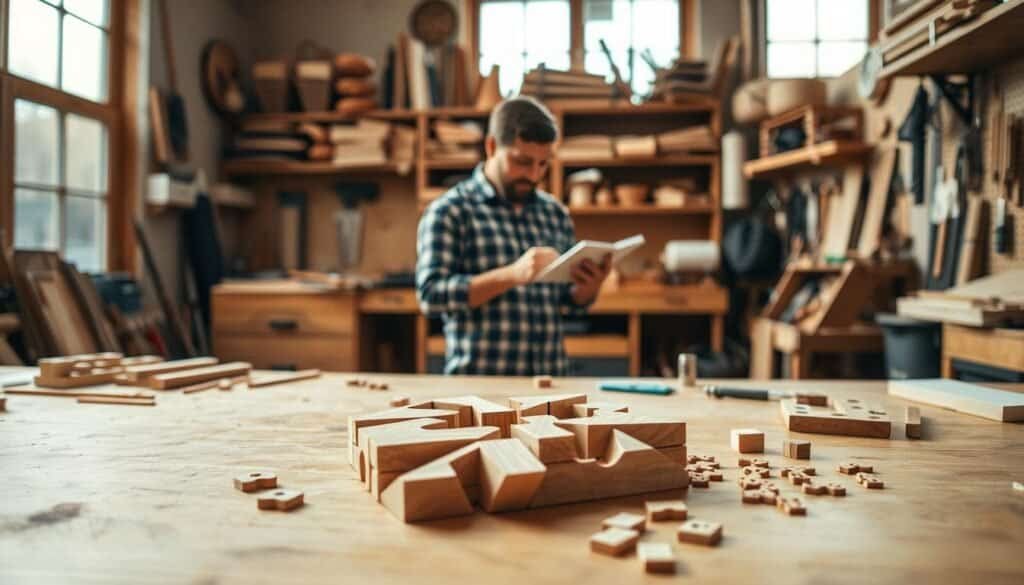
Another challenge is the assembly process. Sometimes, pieces may not align as expected, or the puzzle might not be sturdy. Using the right wood and ensuring accurate cuts can solve these issues.
Tips for Avoiding Mistakes
To minimize errors, always measure twice before cutting. Test your puzzle pieces as you go to ensure they fit smoothly. Sanding the pieces after cutting can also help remove splinters or rough edges.
By knowing these common challenges and how to avoid them, you can make a fun and rewarding DIY wooden puzzle. With practice and patience, you’ll get better at troubleshooting and making high-quality wooden puzzles.
Storage and Display Solutions for Handmade Wooden Puzzles
Handmade wooden puzzles need careful storage and display to keep them looking great. The right storage protects them from damage and keeps them organized. It also makes them easy to find.
Using wooden or plastic boxes with separate spots for each puzzle is a smart choice. It’s perfect for storing many puzzles. It keeps them clean and stops pieces from getting lost.
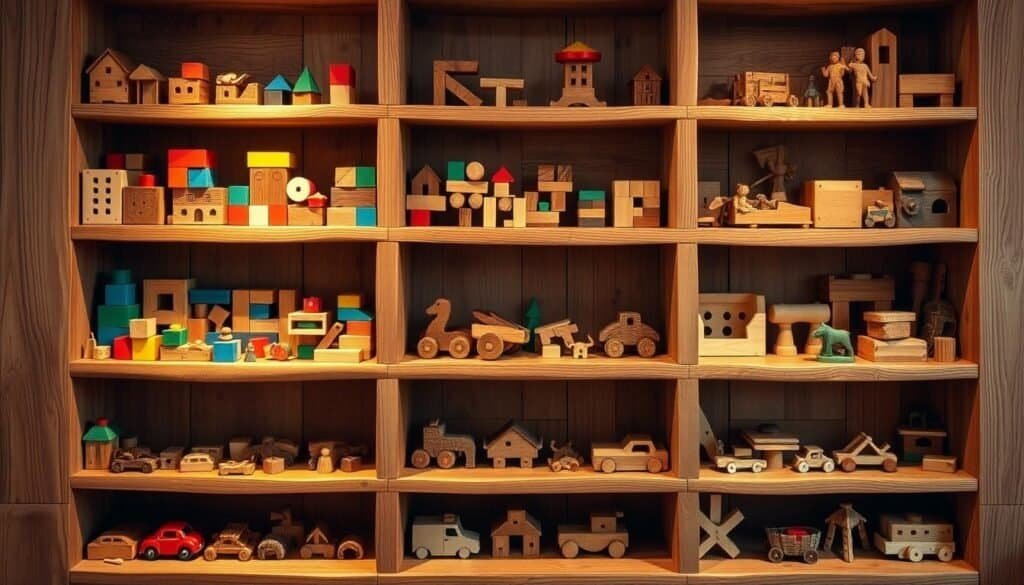
Display stands or wall mounts are great for showing off finished puzzles. They turn your puzzles into beautiful decorations for your home.
Think about your puzzle’s design and size when picking a display. Big puzzles look amazing on sturdy wall mounts. Smaller ones fit well on multi-tiered stands.
With these storage and display ideas, you can enjoy your wooden puzzles for a long time. They’ll stay in great shape and bring you lots of happiness.
Conclusion: The Lasting Value of Handmade Wooden Puzzles
Making DIY wooden puzzles is fun and educational for kids. This tutorial showed you how to make puzzles that help kids solve problems and be creative.
Handmade wooden puzzles are great for learning and bonding with your family. They offer a fun way to spend time together, making them perfect for family activities.
Encouraging Continued Creativity
Keep making DIY wooden puzzles to grow closer to your kids and boost their creativity. The memories and skills you create will last forever, making it all worthwhile.

